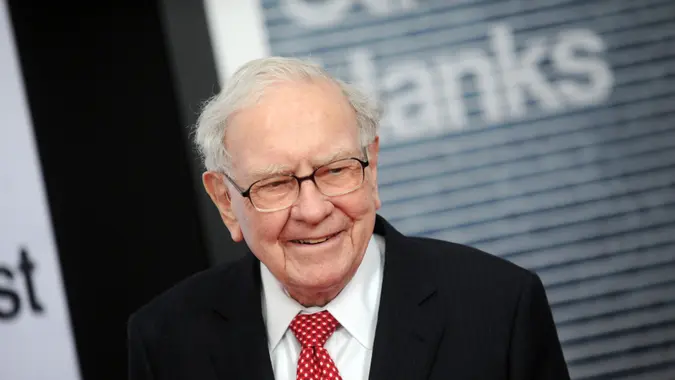5 Biggest Price Hikes Tied to Trump’s 2025 Tariffs

Commitment to Our Readers
GOBankingRates' editorial team is committed to bringing you unbiased reviews and information. We use data-driven methodologies to evaluate financial products and services - our reviews and ratings are not influenced by advertisers. You can read more about our editorial guidelines and our products and services review methodology.

20 Years
Helping You Live Richer

Reviewed
by Experts

Trusted by
Millions of Readers
Tariffs have been a major topic in 2025 as President Donald Trump has imposed them on several major U.S. trading partners to encourage more American-based manufacturing. While the idea may be well intentioned, how have these tariffs actually affected American households?
1. Clothing & Footwear
If you bought new clothing, shoes, leather goods or textiles in 2025, you probably noticed price hikes, said Kyle Peacock, founder of Peacock Tariff Consulting and an international trade and supply chain expert.
“Tariffs on imports from China, Vietnam and Bangladesh drove clothing and footwear prices up 10% to 20%, while wool, silk and leather products rose up to 36%,” he explained.
2. New Cars & Car Parts
If you were in the market for a new vehicle in 2025, you probably felt the pinch at the dealership, too, as prices climbed more than 8%, Peacock noted, especially for models that rely on foreign components.
3. Imported Food
Americans have also seen higher grocery bills on staples such as peanut butter, pizza, dairy products and alcohol, Peacock said, largely “due to retaliatory tariffs from Canada and the EU.” He also pointed out that beef prices have jumped as exporters pull back from selling into the U.S. market.
4. Personal Care
Non-food items people buy regularly, such as shampoos, soaps and toothpaste, have also become more expensive. “These categories were hit hardest due to their reliance on global supply chains,” Peacock explained.
5. Energy
People were already dealing with higher energy costs before 2025, but Chris Motola, a financial analyst with NationalBusinessCapital.com, said that energy has “seen some of the highest inflation in 2025 so far.” He said this may be more attributable to updates to aging infrastructure, as well as higher demand abroad than to tariffs, but it is hard to parse out.
Most Households Paid More
Overall, tariffs cost the average American family between $2,300 and $3,800 per household due to higher prices on everyday goods, Peacock said.
“Lower-income families will feel the impact more severely, with up to 4% of their disposable income lost to inflated prices,” he added.
Because tariffs act like a “hidden tax” — one that is especially painful for budget-conscious families — he said, “Saving money due to tariffs is quite rare, as only households that shift aggressively to domestic alternatives or discount retailers see modest relief.”
Expect Sticky Inflation Around These Products
Unfortunately, 2026 may not bring much relief, Peacock said. “Sticky inflation will persist in imported electronics, luxury fashion and accessories, furniture and home goods and breakfast staples.”
Motola isn’t convinced this means prices will keep rising, however. “Tariffs will exist as an inflationary force, but whether that translates to significantly higher prices in 2026 isn’t clear. There are disinflationary forces at work, too, like weakness in the labor market and wage growth.”
Tariff Hikes May Stabilize but Not Reverse
Forecasts suggest gradual stabilization but not a return to pre-tariff prices, Peacock said. “Core inflation is expected to hover around 3% through mid-2026, and GDP growth may be sluggish, with tariffs permanently lowering economic activity.” Unless the economy changes significantly, he predicts inflation will likely stay elevated through 2026.
Tyler Higgins, managing director of the strategic cost reduction practice at Aarete, agreed. “Two primary impacts will come out of tariffs, even if they are eventually eased. The first is that once new pricing thresholds have been set, you rarely see them contract. A second is that the last areas to change are those where supply chains are the hardest to rewire or reset (electronics and furniture, for example) and contain deep imported inputs.”
Global trade disruption also isn’t expected to ease much in 2026, and prices will likely continue to inch higher, Higgins said.
Sectors Where Tariffs Benefit Investments
There have been a couple of temporary positive outcomes of tariffs, however, Peacock said. “Domestic manufacturing is benefiting from reshoring and reduced foreign competition, though capacity is limited in the immediate term.”
Demand for “nearshoring” and regional supply chains is growing, and companies offering pricing optimization and supply chain tracking tools are seeing more interest.
Some Agricultural Product Prices May Drop
Tariffs are also affecting agriculture in unexpected ways. “The trade war between the U.S. and China appears to be dropping the price of agricultural products we would normally be exporting to them, such as soybeans and pork,” Motola said. While that helps consumers in the short run, it’s not good news for farmers or the broader agricultural industry.
How To Protect Your Budget
The best way to handle persistent tariff-related price hikes is to make strategic choices about spending, Higgins said.
First, he advised, “trade down and look for private labels wherever possible.”
Next, only make major purchases when necessary, not just for convenience or aesthetic upgrades.
“Lastly, look at investments where ROI is possible. If you need a new HVAC or refrigerator, find added benefits such as utilities costs going down,” he said.
 Written by
Written by  Edited by
Edited by 

























